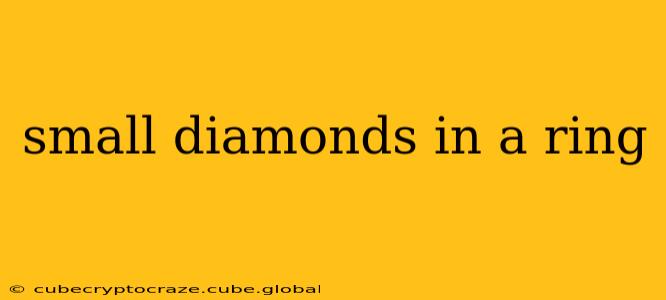Small diamonds in a ring hold a captivating charm, offering a delicate beauty and understated elegance that's perfect for various occasions and personal styles. Whether you're considering a solitaire with a petite gem, a band brimming with tiny diamonds, or a more intricate design, understanding the nuances of small diamond rings can help you find the perfect piece. This guide explores everything you need to know about these exquisite jewels.
What are the different sizes of small diamonds in rings?
The size of a small diamond is typically measured in millimeters (mm) or points. A point is one-hundredth of a carat (0.01ct). While there isn't a strict definition for "small," diamonds under 0.25 carats are generally considered small. This translates to approximately 4mm or smaller in diameter for round brilliant cuts. However, the perceived size can vary depending on the diamond's cut, clarity, and color. A well-cut smaller diamond can appear larger and more brilliant than a poorly cut larger diamond.
What are the most popular settings for small diamonds in rings?
The setting significantly impacts a small diamond's appearance. Popular choices include:
-
Prong Settings: Securely hold the diamond with delicate prongs, allowing maximum light to enter and maximizing brilliance. This is a classic and versatile choice for solitaire rings or small diamonds within larger designs.
-
Bezel Settings: Encircle the diamond with a metal rim, providing excellent protection and a more modern, sleek appearance. This setting is particularly suitable for smaller, more delicate diamonds.
-
Channel Settings: Set small diamonds in a channel or groove within the band, creating a continuous line of sparkle. This style is popular for eternity bands or rings with multiple small diamonds.
-
Pave Settings: Set tiny diamonds closely together across the surface of the band, resulting in a dazzling, textured effect. This setting is ideal for enhancing the overall sparkle of a ring.
How much do small diamond rings cost?
The price of a small diamond ring depends on several factors: the diamond's carat weight, cut, color, clarity, and the metal type used in the setting (platinum, gold, etc.). While smaller diamonds are generally more affordable than larger ones, the quality still plays a significant role in the overall cost. You can find beautiful small diamond rings ranging from a few hundred to several thousand dollars.
What are the pros and cons of small diamonds in rings?
Pros:
- Affordability: Smaller diamonds are often more budget-friendly than larger stones.
- Delicate and understated elegance: They offer a subtle sparkle, perfect for everyday wear.
- Versatility: Suitable for various styles, from classic to modern.
- Durability: When set securely, they are relatively durable.
Cons:
- Less noticeable sparkle: Compared to larger diamonds, they may have less noticeable sparkle, although proper cutting can minimize this.
- Potential for appearing smaller than expected: This depends largely on the cut and setting.
Are small diamonds less valuable?
While smaller diamonds generally cost less than larger ones, their value is still determined by the four Cs (cut, clarity, color, and carat weight). A well-cut, high-clarity, and colorless small diamond can be just as valuable in terms of quality as a larger stone with inferior characteristics. The value lies in the quality, not solely in the size.
What are some popular styles of rings with small diamonds?
Small diamonds can be incorporated into many ring styles:
- Solitaire Rings: Featuring a single small diamond as the focal point.
- Eternity Bands: Featuring small diamonds set all the way around the band.
- Three-Stone Rings: Often featuring a larger center stone flanked by two smaller diamonds.
- Halo Rings: A center diamond surrounded by a halo of smaller diamonds.
- Bezel Rings: A small diamond secured in a bezel setting.
Choosing a ring with small diamonds offers a balance of elegance, affordability, and versatility. Consider your personal style, budget, and desired level of sparkle when selecting the perfect piece. Remember that the quality of the diamond, rather than just the size, should be a primary consideration.
